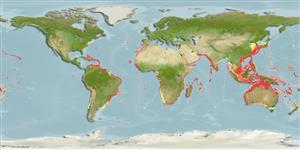Classification / Names
Common names | Synonyms | Catalog of Fishes (gen., sp.) | ITIS | CoL | WoRMS | Cloffa
Actinopterygii (ray-finned fishes) >
Aulopiformes (Grinners) >
Synodontidae (Lizardfishes) > Synodontinae
Etymology: Synodus: Greek, syn, symphysis = grown together + Greek, odous = teeth (Ref. 45335).
Issue
The genus Trachinocephalus is a synonym of Synodus after Chaiyapo (2013, IPFC9, in press).
Environment / Climate / Range
Ecology
Marine; reef-associated; depth range ? - 400 m (Ref. 9710), usually 3 - 90 m (Ref. 4472). Tropical, preferred ?; 40°N - 40°S, 76°W - 154°W
Worldwide in tropical and warm temperate waters with the exception of the eastern Pacific and the northeast Atlantic north of Cape Blanc, Africa.
Length at first maturity / Size / Weight / Age
Maturity: Lm ?, range 19 - ? cm
Max length : 40.0 cm TL male/unsexed; (Ref. 9710); common length : 25.0 cm TL male/unsexed; (Ref. 5217); max. reported age: 7 years (Ref. 36558)
Dorsal
spines
(total): 0;
Dorsal
soft rays
(total): 11-14;
Anal
spines: 0;
Anal
soft rays: 13 - 18. Snout very short; mouth very oblique; body with alternating narrow dark-edged pale blue and yellow stripes; oblique black spot at the upper end of the gill opening (Ref. 2334). Eye far forward (Ref. 26938).
Found near shore above 40 m over sandy bottoms of deep outer reef slopes (Ref. 11230). Reported to be common in estuaries (Ref. 11228, 48635). Benthic at 3-388 m (Ref. 58302). Rest on or more often burrow into substrate, leaving eyes exposed (Ref. 4472, 48635). When disturbed, it may swim a short distance but quickly buries itself again (Ref. 48635). Feed on fishes (Ref. 5213) and small crustaceans (Ref. 36558).
Sulak, K.J., 1990. Synodontidae. p. 365-370. In J.C. Quero, J.C. Hureau, C. Karrer, A. Post and L. Saldanha (eds.) Check-list of the fishes of the eastern tropical Atlantic (CLOFETA). JNICT, Lisbon; SEI, Paris; and UNESCO, Paris. Vol. 1. (Ref. 4472)
IUCN Red List Status (Ref. 115185)
CITES (Ref. 94142)
Not Evaluated
Threat to humans
Harmless
Human uses
Fisheries: minor commercial
More information
ReferencesAquacultureAquaculture profileStrainsGeneticsAllele frequenciesHeritabilityDiseasesProcessingMass conversion
Tools
Special reports
Download XML
Internet sources
